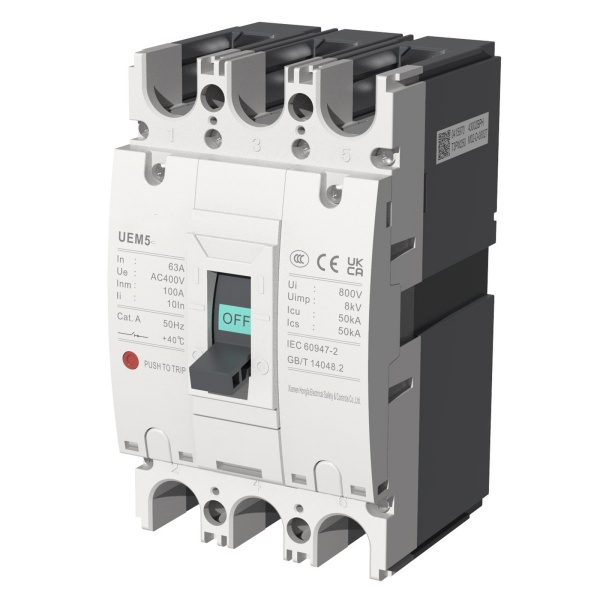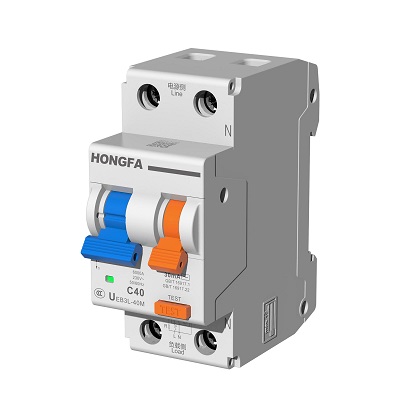In modern electrical engineering, low-voltage circuit breakers play a vital role. Apart from their connection and disconnection of circuits, they also offer required protective features including undervoltage and leakage protection, overload, short circuit, protection from This article will introduce the classification and structure of low-voltage circuit breakers in detail to help readers understand this key electrical equipment more deeply.

UEM5 AC MCCB Circuit Breaker
1 Overview
There are many ways to classify low-voltage circuit breakers. According to the use category, there are selective type (protection device parameters are adjustable) and non-selective type (protection device parameters are not adjustable); according to the structural type, there are universal type (also known as frame type) and molded case circuit breakers; according to the arc extinguishing medium, there are air type and vacuum type (currently most domestic products are air type); according to the operation mode, there are manual operation, electric operation and spring energy storage mechanical operation; according to the number of poles, it can be divided into single-pole, two-pole, three-pole and four-pole types; according to the installation method, there are fixed type, plug-in type, drawer type and embedded type. The capacity range of low-voltage circuit breakers is very large, with a minimum of 4A and a maximum of 5000A.
Low-voltage circuit breakers are widely used in feeder lines at all levels of low-voltage distribution systems, power supply control of various mechanical equipment, and control and protection of power terminals.
2 Structure of low-voltage circuit breakers
Low-voltage circuit breakers consist of contacts, arc extinguishing devices, running mechanisms and safety devices.
2.1 Contact system
Circuit breakers link or disconnect circuits using contacts—static contacts as well as moving contacts.
The fundamental needs for contacts are: (1) they can safely and consistently connect and disconnect circuit currents up to the limit short-circuit current; (2) they can work at a long-term working current; (3) they will not be seriously worn after connection and disconnection within the specified number of electrical lifespans.
Circuit breakers typically have butt-joint contacts, bridge contacts, and plug-in contacts among the several contact types utilized there. Silver-based alloy inserts are welded on the primarily surface contacts, or line contacts, butt-joint and bridge contacts. Apart from the primary contacts, every phase of big circuit breakers features auxiliary and arc contacts.
The circuit breaker contacts in an action sequence whereby the arc contact closes first, then the auxiliary contact closes, and lastly the main contact closes; when the circuit breaker is disengaged, the reverse. The load current is carried by the main contact; the auxiliary contact is utilized to guard the main contact; and the arc contact bears the arc burning upon a cut off of the current. The arc only forms on the arc contact, therefore guaranteeing that the main contact is not scorched by the arc and operates stably for a long period.
2.2 Arc extinguishing system
The arc extinguishing system is used to extinguish the arc generated between the contacts when the circuit is disconnected. Two components make up the arc extinguishing system: an arc extinguishing chamber above the contacts and a powerful spring mechanism enabling the separation of the circuit breaker contacts rapidly.
2.3 Operating mechanism
Two components form the circuit breaker functioning mechanism: a tripping mechanism and a transmission mechanism.
The several operation modes of the circuit breaker help one to divide the transmission mechanism into manual, lever, electromagnet, and motor transmission; depending on the closing mode, it can be divided into energy storage closing and non-energy storage closing.
The free tripping mechanism serves to realize the link between the contact system and the transmission mechanism.
2.4 Protection device
Different trippers allow the circuit breaker to realize its protection mechanism.
Undervoltage tripper, overcurrent tripper, shunt tripper, etc. are the several tripping forms of the circuitbreaker. Additionally separate overcurrent tripper into overload tripper and short-circuit tripper.
The working voltage’s variation is watched with the undervoltage tripper. The circuit breaker can be disengaged right once either the grid fails or the voltage falls to 70%~35% of the rated voltage. A lower power supply voltage than 35% of the rated voltage can cause the circuit breaker to fail shutting. The undervoltage tripper with delayed action can stop the voltage fluctuation resulting from the unexpected load rise by misconnecting the circuit breaker. One could find 1s, 3s, and 5s as the delay times.
To disconnect the circuit breaker, remote control or thermal relay uses the shunt tripper.
Load side short circuits and overload is avoided using an overcurrent tripper.
Usually, circuit breakers also feature a short-circuit locking mechanism, which keeps the breaker from closing once the fault is removed when it is unplugged. The circuit breaker is disconnected under short-circuit situations, and the locking mechanism is triggered to maintain the disconnected state of affairs. The circuit cannot be connected or the circuit breaker closing mechanism actuated before the locking mechanism is reset.

Residual Current Circuit Breaker 2 Pole
2.5 Others
Apart from the four above kinds of devices, the circuit breaker features auxiliary connections—usually either normally open or normally closed contacts. Signal devices and intelligent control devices are built on auxiliary contacts. Additionally there are plastic bases and shells ( manufactured case circuit breakers) and frames (universal circuit breakers).
Post time: 7 月-18-2024


